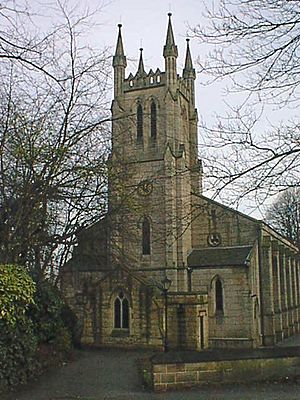Holy Trinity Church, Chesterfield facts for kids
Quick facts for kids Holy Trinity Church, Chesterfield |
|
|---|---|

Holy Trinity Church, Chesterfield
|
|
| 53°14′24.53″N 1°25′43.61″W / 53.2401472°N 1.4287806°W | |
| Location | Chesterfield |
| Country | England |
| Denomination | Church of England |
| Website | holytrinityandchristchurch.org |
| History | |
| Dedication | Holy Trinity |
| Architecture | |
| Heritage designation | Grade II listed |
| Architect(s) | Thomas Johnson |
| Completed | 1838 |
| Administration | |
| Parish | Chesterfield Holy Trinity and Christ Church |
| Deanery | Chesterfield |
| Archdeaconry | Chesterfield |
| Diocese | Diocese of Derby |
Holy Trinity Church, Chesterfield is a special church located in Chesterfield, Derbyshire, England. It is part of the Church of England. This church is considered a Grade II listed building. This means it is an important historical building that is protected.
Contents
The Church's Story
Building Holy Trinity Church
The first stone for Holy Trinity Church was placed on May 17, 1837. A very important person, the Duke of Devonshire, laid this stone. The church was designed by an architect named Thomas Johnson. It was finished and ready for use in 1838.
Over the years, the church has had some changes. In 1889, Samuel Rollinson made some updates to the building. Later, in 1938, a new room for the choir was added.
Famous Connections
Holy Trinity Church is well-known because of a very important person buried there. This person is George Stephenson, a famous railway engineer. He passed away in 1848. You can find a simple stone slab on the floor inside the church that marks his grave.
George Stephenson's son, Robert, also wanted to remember his father. He paid for a beautiful stained glass window. This window is at the east end of the church.
Working Together
Today, Holy Trinity Church works closely with another church nearby. It shares a parish with Christ Church, Chesterfield. This means they are part of the same church community.
Inside the Church
The Organ
For many years, the church had a pipe organ. This organ was made by a company called Brindley and Foster in 1868. Organs are large musical instruments that make sound using air through pipes.
Images for kids


